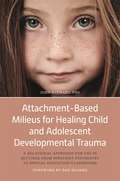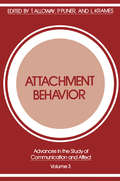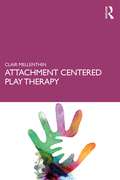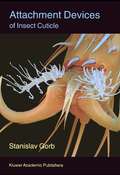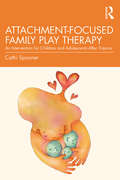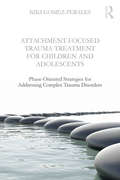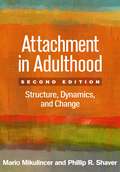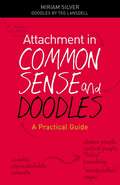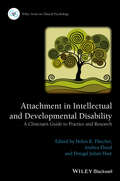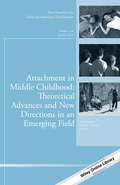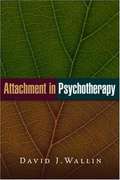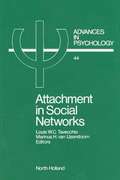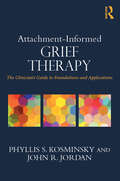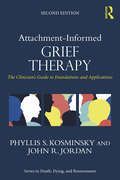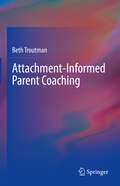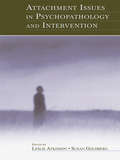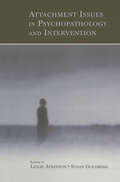- Table View
- List View
Attachment-Based Milieus for Healing Child and Adolescent Developmental Trauma (PDF)
by John Stewart Dan HughesThis book presents an innovative relational and community based therapeutic model to ensure children's essential attachment needs are catered for in intensive mental health care. The text combines an overview of theory relating to attachment and trauma before laying out a model for working with children and adolescents in an attachment-informed way. The approach applies to a diverse range of settings - from in-patient psychiatric settings, through to schools-based programs, and provides the reader with the knowledge and guidance they need to introduce the approach in their own service. It also addresses the complexities of working with specific clinical populations, including children with ADHD, ASD, RAD and psychosis. Accessible for entry level clinical caretakers, yet sophisticated enough for clinical supervisors, this book is essential reading for professionals looking to improve the effectiveness of child and adolescent treatment programs.
Attachment Centered Play Therapy
by Clair MellenthinAttachment Centered Play Therapy offers clinicians a holistic, play-based approach to child and family therapy that is presented through the lens of attachment theory. Along the way, chapters explore the theoretical underpinnings of attachment theory to provide a foundational understanding of the theory while also supplying evidence-based interventions, practical strategies, and illuminative case studies. This informative new resource strives to combine theory and practice in a single intuitive model designed to maximize the child-parent relationship, repair attachment wounds, and address underlying symptoms of trauma.
Attachment Centered Play Therapy
by Clair MellenthinAttachment Centered Play Therapy offers clinicians a holistic, play-based approach to child and family therapy that is presented through the lens of attachment theory. Along the way, chapters explore the theoretical underpinnings of attachment theory to provide a foundational understanding of the theory while also supplying evidence-based interventions, practical strategies, and illuminative case studies. This informative new resource strives to combine theory and practice in a single intuitive model designed to maximize the child-parent relationship, repair attachment wounds, and address underlying symptoms of trauma.
Attachment Devices of Insect Cuticle
by Stanislav S. GorbIn 1974 when I published my book, Biological Mechanism of Attachment, not many pages were required to report on the attachment devices of insect cuticles. As in most fields of research, our knowledge on this specific subject has simply exploded. Dr. Stanislav N. Gorb now describes the present day level of our knowledge, to which he has personally contributed so much, and a research team working on biological microtribology has gradually developed, also. With modern methods of measurement it is possible to enter the structure – function relationship much more deeply, even down to a molecular level, which was not possible two and a half decades ago. It is a well known fact that, in biology, the more sophisticated the measuring method, the greater the achievement of biological fundamental research, and its resulting evidence. Our knowledge remains at a certain level until new methods once more permit a forward leap. Biological knowledge develops in the form of a stepped curve rather than linear, as reflected in the studies carried out on the attachment devices of insect cuticles.
Attachment-Focused Family Play Therapy: An Intervention for Children and Adolescents after Trauma
by Cathi SpoonerAttachment-Focused Family Play Therapy presents an essential roadmap for therapists working with traumatized youth. Exploring trauma and attachment through a neurobiological focus, the book lays out a flexible framework for practitioners treating young clients within the context of their family relationships. Chapters demonstrate how techniques of play and expressive therapy can be integrated into work with different developmental stages, while providing the tools needed to fully incorporate the family into the healing process. The book also provides clinical examples and guidance on the ethical decision-making needed to effectively implement attachment work and facilitate positive change. Written in an accessible style, Attachment-Focused Family Play Therapy is an important resource for mental health professionals who work with traumatized children, adolescents, and adults.
Attachment-Focused Family Play Therapy: An Intervention for Children and Adolescents after Trauma
by Cathi SpoonerAttachment-Focused Family Play Therapy presents an essential roadmap for therapists working with traumatized youth. Exploring trauma and attachment through a neurobiological focus, the book lays out a flexible framework for practitioners treating young clients within the context of their family relationships. Chapters demonstrate how techniques of play and expressive therapy can be integrated into work with different developmental stages, while providing the tools needed to fully incorporate the family into the healing process. The book also provides clinical examples and guidance on the ethical decision-making needed to effectively implement attachment work and facilitate positive change. Written in an accessible style, Attachment-Focused Family Play Therapy is an important resource for mental health professionals who work with traumatized children, adolescents, and adults.
Attachment-Focused Trauma Treatment for Children and Adolescents: Phase-Oriented Strategies for Addressing Complex Trauma Disorders
by Niki Gomez-PeralesAttachment-Focused Trauma Treatment for Children and Adolescents brings together two powerful treatment directions that exponentially expand the knowledge and skills available to child and adolescent trauma therapists. The book provides theoretical knowledge, clinical approaches, and specific, detailed techniques that clinicians will find indispensable in the treatment of the most challenging and high-risk young trauma victims. Also included are case studies, developed from over three decades of experience, that show the reader how to use the techniques in real-life settings. The treatment approach described here is flexible enough to adapt to real clients in the real world, regardless of trauma and attachment histories, family and living situations, or difficulties engaging in supportive therapeutic relationships. Clear and cohesive, the model presented here allows room for the individuality and approach of each therapist so that the therapeutic relationship can evolve in a genuine and unique way. An appendix of photocopiable worksheets gives interactive tools for therapists to immediately use with clients.
Attachment-Focused Trauma Treatment for Children and Adolescents: Phase-Oriented Strategies for Addressing Complex Trauma Disorders
by Niki Gomez-PeralesAttachment-Focused Trauma Treatment for Children and Adolescents brings together two powerful treatment directions that exponentially expand the knowledge and skills available to child and adolescent trauma therapists. The book provides theoretical knowledge, clinical approaches, and specific, detailed techniques that clinicians will find indispensable in the treatment of the most challenging and high-risk young trauma victims. Also included are case studies, developed from over three decades of experience, that show the reader how to use the techniques in real-life settings. The treatment approach described here is flexible enough to adapt to real clients in the real world, regardless of trauma and attachment histories, family and living situations, or difficulties engaging in supportive therapeutic relationships. Clear and cohesive, the model presented here allows room for the individuality and approach of each therapist so that the therapeutic relationship can evolve in a genuine and unique way. An appendix of photocopiable worksheets gives interactive tools for therapists to immediately use with clients.
Attachment In Adulthood, Second Edition: Structure, Dynamics, And Change (PDF)
by Mario Mikulincer Phillip R. ShaverSynthesizing a vast body of empirical research and organizing it around a comprehensive conceptual model, this book is recognized as the definitive reference on adult attachment. The authors explain how what began as a theory of child development is now used to conceptualize and study nearly all aspects of social functioning across the lifespan, including mental representations of self and others, emotion regulation, personal goals and strivings, couple relationships, caregiving, sexuality, psychopathology, psychotherapy, and organizational behavior. The origins and measurement of individual differences in adult attachment are examined, as is the question of whether and how attachment patterns can change.
Attachment in Common Sense and Doodles: A Practical Guide
by Miriam SilverAttachment is a word used to describe a simple idea - the relationship with someone you love or whose opinions are important to you - so why is so much of the language relating to attachment so obscure, and why is it so challenging to help children who lack healthy attachment bonds? Attachment in Common Sense and Doodles aims to bring some clarity and simplicity to the subject. Providing grounded information and advice accompanied by a series of simple 'doodles' throughout, it explains attachment in language that is easy to understand and describes how to apply this information in everyday life. It describes how the attachment patterns in children who are adopted or fostered differ, summarises the latest research in the field and provides advice on how to repair attachment difficulties and to build secure, loving relationships. Covering all of the 'need to know' issues including how to spot attachment difficulties, build resilience and empathy and responding to problematic behaviour, this book will be an invaluable resource for families and professionals caring for children who are fostered, adopted or who have experienced early trauma.
Attachment in Common Sense and Doodles: A Practical Guide (PDF)
by Miriam SilverAttachment is a word used to describe a simple idea – the relationship with someone you love or whose opinions are important to you – so why is so much of the language relating to attachment so obscure, and why is it so challenging to help children who lack healthy attachment bonds? Attachment in Common Sense and Doodles aims to bring some clarity and simplicity to the subject. Providing grounded information and advice accompanied by a series of simple 'doodles' throughout, it explains attachment in language that is easy to understand and describes how to apply this information in everyday life. It describes how the attachment patterns in children who are adopted or fostered differ, summarises the latest research in the field and provides advice on how to repair attachment difficulties and to build secure, loving relationships. Covering all of the 'need to know' issues including how to spot attachment difficulties, build resilience and empathy and responding to problematic behaviour, this book will be an invaluable resource for families and professionals caring for children who are fostered, adopted or who have experienced early trauma.
Attachment in Intellectual and Developmental Disability: A Clinician's Guide to Practice and Research (Wiley Series in Clinical Psychology)
by Helen K. Fletcher Andrea Flood Dougal Julian HareAttachment in Intellectual and Developmental Disability: A Clinician’s Guide to Practice and Research is the first book to explore the clinical difficulties associated with attachment relationships in people with intellectual and developmental disabilities. Draws together knowledge from disparate sources in a definitive new resource for clinicians working in this area A growing body of evidence-based approaches in this area are underpinned by attachment theory, including direct intervention and the use of attachment theory to understand interactions and relationships Presents and integrates cutting-edge models and approaches that have previously been available only to specialists Written by mainstream practitioners who are active in clinical work and research; focused on real-world applications, with illustrative case examples throughout
Attachment in Intellectual and Developmental Disability: A Clinician's Guide to Practice and Research (Wiley Series in Clinical Psychology)
by Helen K. Fletcher Andrea Flood Dougal Julian HareAttachment in Intellectual and Developmental Disability: A Clinician’s Guide to Practice and Research is the first book to explore the clinical difficulties associated with attachment relationships in people with intellectual and developmental disabilities. Draws together knowledge from disparate sources in a definitive new resource for clinicians working in this area A growing body of evidence-based approaches in this area are underpinned by attachment theory, including direct intervention and the use of attachment theory to understand interactions and relationships Presents and integrates cutting-edge models and approaches that have previously been available only to specialists Written by mainstream practitioners who are active in clinical work and research; focused on real-world applications, with illustrative case examples throughout
Attachment in Middle Childhood: New Directions for Child and Adolescent Development, Number 148 (J-B CAD Single Issue Child & Adolescent Development)
by Guy Bosmans Kathryn A. KernsOne of the critical factors in early development is the formation of a secure attachment, and it continues to be important for older children's responses to psychological stressors like hurt pride, fear, and sadness. This volume provides a timely review of research to date, describing important insights that have both theoretical and clinical importance as well as identifying remaining gaps in our understanding.Summarizing the most relevant findings, this volume is important for theory on child (attachment) development, and also for clinicians to broaden their understanding of the importance of middle childhood attachment processes for understanding the development of children’s behavior problems and for designing effective treatment strategies.This is the 148th volume in this Jossey-Bass series New Directions for Child and Adolescent Development. Its mission is to provide scientific and scholarly presentations on cutting edge issues and concepts in this subject area. Each volume focuses on a specific new direction or research topic and is edited by experts from that field.
Attachment in Middle Childhood: New Directions for Child and Adolescent Development, Number 148 (J-B CAD Single Issue Child & Adolescent Development)
by Guy Bosmans Kathryn A. KernsOne of the critical factors in early development is the formation of a secure attachment, and it continues to be important for older children's responses to psychological stressors like hurt pride, fear, and sadness. This volume provides a timely review of research to date, describing important insights that have both theoretical and clinical importance as well as identifying remaining gaps in our understanding.Summarizing the most relevant findings, this volume is important for theory on child (attachment) development, and also for clinicians to broaden their understanding of the importance of middle childhood attachment processes for understanding the development of children’s behavior problems and for designing effective treatment strategies.This is the 148th volume in this Jossey-Bass series New Directions for Child and Adolescent Development. Its mission is to provide scientific and scholarly presentations on cutting edge issues and concepts in this subject area. Each volume focuses on a specific new direction or research topic and is edited by experts from that field.
Attachment In Psychotherapy (PDF)
by David J. WallinThis eloquent book translates attachment theory and research into an innovative framework that grounds adult psychotherapy in the facts of childhood development. Advancing a model of treatment as transformation through relationship, the author integrates attachment theory with neuroscience, trauma studies, relational psychotherapy, and the psychology of mindfulness. Vivid case material illustrates how therapists can tailor interventions to fit the attachment needs of their patients, thus helping them to generate the internalized secure base for which their early relationships provided no foundation. Demonstrating the clinical uses of a focus on nonverbal interaction, the book describes powerful techniques for working with the emotional responses and bodily experiences of patient and therapist alike.
Attachment in Social Networks: Contributions to the Bowlby-Ainsworth Attachment Theory (ISSN #Volume 44)
by L W C Tavecchio M. H. Van IJzendoornThe main objective of the research presented in this book is to broaden the scope of attachment theory by stressing the importance of a social network approach to the study of attachment.This approach forms the integrating theme of this volume, as is testified by various studies of attachment as it develops in an "extended" rearing context over and beyond the limits of the traditional mother-child dyad. In this connection attention is paid to the importance of sibling relationships, attachment relationships with professional caregivers, the role of the father in caring and rearing young children, and the (short-term and long-term) effects on attachment quality of maternal employment in infancy. Also, the cross-cultural validity of Ainsworth's Strange Situation is discussed, with reference to the USA, Sweden, Israel, Japan, The Netherlands, etc. In adopting a social network approach, the attachment theory proves to be a particularly useful instrument for reflecting on the consequence of social change (maternal employment, symmetrical families, socialisation of childrearing) for child development.
Attachment-Informed Grief Therapy: The Clinician’s Guide to Foundations and Applications (Series in Death, Dying, and Bereavement)
by Phyllis S. Kosminsky John R. JordanAttachment-Informed Grief Therapy bridges the fields of attachment studies and thanatology, uniting theory, research, and practice to enrich our understanding of how and why people grieve and how we can help the bereaved. In its pages, clinicians and students will gain a new understanding of the etiology of complicated grief and its treatment and will become better equipped to formulate accurate and specific case conceptualization and treatment plans. The authors also illustrate the ways in which the therapeutic relationship is a crucially important—though largely unrecognized—element in grief therapy, and offer guidelines for an attachment informed view of the therapeutic relationship that can serve as the foundation of all grief therapy.
Attachment-Informed Grief Therapy: The Clinician’s Guide to Foundations and Applications (Series in Death, Dying, and Bereavement)
by Phyllis S. Kosminsky John R. JordanAttachment-Informed Grief Therapy bridges the fields of attachment studies and thanatology, uniting theory, research, and practice to enrich our understanding of how and why people grieve and how we can help the bereaved. In its pages, clinicians and students will gain a new understanding of the etiology of complicated grief and its treatment and will become better equipped to formulate accurate and specific case conceptualization and treatment plans. The authors also illustrate the ways in which the therapeutic relationship is a crucially important—though largely unrecognized—element in grief therapy, and offer guidelines for an attachment informed view of the therapeutic relationship that can serve as the foundation of all grief therapy.
Attachment-Informed Grief Therapy: The Clinician’s Guide to Foundations and Applications (Series in Death, Dying, and Bereavement)
by Phyllis S. Kosminsky John R. JordanAttachment-Informed Grief Therapy bridges the fields of attachment studies, thanatology, and interpersonal neuroscience, uniting theory, research, and practice to enrich our understanding of how we can help the bereaved. The new edition includes updated research and discussion of emotion regulation, relational trauma, epistemic trust, and much more. In these pages, clinicians and students will gain a new understanding of the etiology of problematic grief and its treatment, and will become better equipped to formulate accurate and specific case conceptualization and treatment plans. The authors also illustrate the ways in which the therapeutic relationship is crucially important – though largely unrecognized – element in grief therapy and offer guidelines for an attachment-informed view of the therapeutic relationship that can serve as the foundation of all grief therapy. Written by two highly experienced grief counselors, this volume is filled with instructive case vignettes and useful techniques that offer a universal and practical frame of reference for understanding grief therapy for clinicians of every theoretical persuasion.
Attachment-Informed Grief Therapy: The Clinician’s Guide to Foundations and Applications (Series in Death, Dying, and Bereavement)
by Phyllis S. Kosminsky John R. JordanAttachment-Informed Grief Therapy bridges the fields of attachment studies, thanatology, and interpersonal neuroscience, uniting theory, research, and practice to enrich our understanding of how we can help the bereaved. The new edition includes updated research and discussion of emotion regulation, relational trauma, epistemic trust, and much more. In these pages, clinicians and students will gain a new understanding of the etiology of problematic grief and its treatment, and will become better equipped to formulate accurate and specific case conceptualization and treatment plans. The authors also illustrate the ways in which the therapeutic relationship is crucially important – though largely unrecognized – element in grief therapy and offer guidelines for an attachment-informed view of the therapeutic relationship that can serve as the foundation of all grief therapy. Written by two highly experienced grief counselors, this volume is filled with instructive case vignettes and useful techniques that offer a universal and practical frame of reference for understanding grief therapy for clinicians of every theoretical persuasion.
Attachment-Informed Parent Coaching
by Beth TroutmanThis book examines attachment-informed parent coaching to address emotional and behavioral problems of young children. The volume summarizes relevant developmental and attachment theory research and describes how it supports an attachment-informed parent coaching approach. The book addresses the challenges of parenting young children with disruptive behavior or who are emotionally reactive, and how mental health providers can help parents address these challenges. Chapters describe how therapists can use their observations of parents and children interacting to tailor parent coaching according to different child and adult attachment patterns. It discusses the important role of adult attachment in tailoring parent coaching, including an understanding of how the therapist’s working model of attachment influences their work with families. Each chapter includes information on current research as well as rich examples of how this research can inform clinical practice. Key areas of coverage include: The role of adult attachment in working with young children. Addressing secure, ambivalent/resistant, avoidant, disorganized, and controlling child-parent dyads. Coaching parents who have a secure, earned secure, preoccupied, dismissing, or unresolved working model of attachment. Working with adopted children and children in foster care. This book is an essential resource for researchers, professors, and graduate students as well as clinicians and professionals in developmental psychology, social work, pediatrics, family studies, nursing, child psychiatry, pediatrics, occupational therapy, and early childhood education.
Attachment Issues in Psychopathology and Intervention
by Leslie Atkinson Susan GoldbergTo be a human being (or indeed to be a primate) is to be attached to other fellow beings in relationships, from infancy on. This book examines what happens when the mechanisms of early attachment go awry, when caregiver and child do not form a relationship in which the child finds security in times of uncertainty and stress. Although John Bowlby, a psychiatrist and psychoanalyst, originally formulated attachment theory for the express purpose of understanding psychopathology across the life span, the concept of attachment was first adopted by psychologists studying typical development. In recent years, clinicians have rediscovered the potential of attachment theory to help them understand psychological/psychiatric disturbance, a potential that has now been amplified by decades of research on typical development. Attachment Issues in Psychopathology and Intervention is the first book to offer a comprehensive overview of the implications of current attachment research and theory for conceptualizing psychopathology and planning effective intervention efforts. It usefully integrates attachment considerations into other frameworks within which psychopathology has been described and points new directions for investigation. The contributors, who include some of the major architects of attachment theory, link what we have learned about attachment to difficulties across the life span, such as failure to thrive, social withdrawal, aggression, anxiety, depression, bipolar disorder, dissociation, trauma, schizo-affective disorder, narcissistic personality disorder, eating disorders, and comorbid disorders. While all chapters are illuminated by rich case examples and discuss intervention at length, half focus solely on interventions informed by attachment theory, such as toddler-parent psychotherapy and emotionally focused couples therapy. Mental health professionals and researchers alike will find much in this book to stimulate and facilitate effective new approaches to their work.
Attachment Issues in Psychopathology and Intervention
by Leslie Atkinson Susan GoldbergTo be a human being (or indeed to be a primate) is to be attached to other fellow beings in relationships, from infancy on. This book examines what happens when the mechanisms of early attachment go awry, when caregiver and child do not form a relationship in which the child finds security in times of uncertainty and stress. Although John Bowlby, a psychiatrist and psychoanalyst, originally formulated attachment theory for the express purpose of understanding psychopathology across the life span, the concept of attachment was first adopted by psychologists studying typical development. In recent years, clinicians have rediscovered the potential of attachment theory to help them understand psychological/psychiatric disturbance, a potential that has now been amplified by decades of research on typical development. Attachment Issues in Psychopathology and Intervention is the first book to offer a comprehensive overview of the implications of current attachment research and theory for conceptualizing psychopathology and planning effective intervention efforts. It usefully integrates attachment considerations into other frameworks within which psychopathology has been described and points new directions for investigation. The contributors, who include some of the major architects of attachment theory, link what we have learned about attachment to difficulties across the life span, such as failure to thrive, social withdrawal, aggression, anxiety, depression, bipolar disorder, dissociation, trauma, schizo-affective disorder, narcissistic personality disorder, eating disorders, and comorbid disorders. While all chapters are illuminated by rich case examples and discuss intervention at length, half focus solely on interventions informed by attachment theory, such as toddler-parent psychotherapy and emotionally focused couples therapy. Mental health professionals and researchers alike will find much in this book to stimulate and facilitate effective new approaches to their work.
